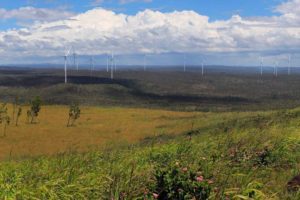Fortescue Metals says its so-called zero emissions “Infinity Train” – one of the key technologies that will come with the $US221 million purchase of the renowned Williams Advanced Engineering – could be on its private rail network within two years.
The infinity train proposes to use the height of Fortescue’s iron ore mines – up to 600m above sea level – and the weight of its load (34,000 tonnes) to provide “regenerative power” to its battery electric locomotives.
The idea is that it will generate enough power down hill to take the massive iron ore trains all the way to port, and put enough charge in the batteries so they can return the empty trains up hill to the mines. It could save 82 million litres of diesel a year.
“They’ll be working as rapidly as they can. I would say it’s in, I guess, 18 to 24 months, really will be the timeframe for the Infinity Train,” CEO Elizabeth Gaines told journalists on Thursday, in response to a question from RenewEconomy.
The Infinity Train is one of more fascinating and novel projects emerging from Fortescue’s push into green energy through its Fortescue Future Industries offshoot and its accelerated zero emissions targets.
Fortescue is spending $50 million on the Infinity Train project alone, and believes it could save up to 82 million litres of diesel a year that it currently uses in its 16-train fleet, each about 2.8kms long and carrying up to 34,000 tonnes of iron ore.
It works on the principle that gravity is a useful force for the green energy future. Gravity underpins pumped hydro storage, where water is pumped up to a higher resevoir and allowed to flow down to spin the generator when needed, and a range of new “gravity based” storage technologies that – like the Infinity Train – are yet to be proven.
In a recent episode of the Energy Insiders podcast, FFI chief executive Julie Shuttleworth gave more details about the technology.
“These trains are long, they’re heavy, they’re fully loaded, they go downhill on the way from the mine sites to the Port Hedland port to offload,” she said.
“During that time that gravitational energy will fully recharge the battery electric systems, and then it will be able to return to the mine site unloaded to fill up its cargo without any recharging.
“And so working together with Williams and their scientists and engineers, their and their battery systems management systems in the advanced electrical systems on mobile equipment, combining all that together will enable us to develop this train.”
Shuttleworth said the beauty of this technology is that it would avoid any recharging infrastructure, which not only takes time, but is also expensive, and requires wind and solar resources to recharge it to be zero emissions.
“So what we’re aiming to do is to make the battery electric systems on that train sufficient enough to create its own electricity through the down downhill, fully loaded haul, so that it can go back again.
“And of course, this is not just a matter of reducing carbon emissions, this will lower operating costs, reduce maintenance, create efficiencies, productivity opportunities, there’s a whole lot of positives that will come out of this project.”
See also: Energy Insiders Podcast: Fortescue’s grand green energy plans










